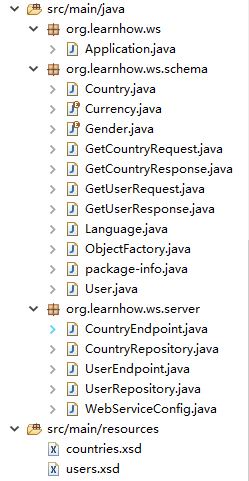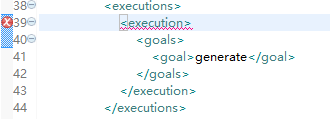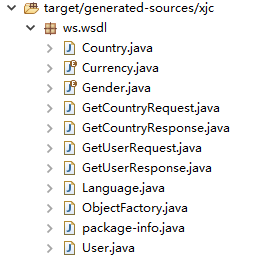30分钟学会使用Spring Web Services基础开发
时隔一年终于又推出了一篇30分钟系列,上一篇《30分钟学会反向Ajax》是2016年7月的事情了。时光荏苒,岁月穿梭。虽然一直还在从事Java方面的开发工作,但是私下其实更喜欢使用C++。不过今天,我们要再次回归到Java的主题,来谈一谈如何使用——Spring Web Services框架。
Spring Web Services(下简称ws)本质上是基于SpringBoot的项目,因此如果有对SpringBoot不太了解的同学,回头再来看比较合适。
ws分为server端与client端两个部分,本文旨在介绍框架搭建的流程与重点。
一、ws.server端搭建
建立Server的关键是首先建立xsd文件。xsd文件是xml文件的定义与基础,你希望别人如何访问与获取你的数据都需要在xsd文件中说明。
countries.xsd
<xs:schema xmlns:xs="http://www.w3.org/2001/XMLSchema"
xmlns:tns="http://learnhow.org/ws/schema" targetNamespace="http://learnhow.org/ws/schema"
elementFormDefault="qualified">
<xs:element name="getCountryRequest">
<xs:complexType>
<xs:sequence>
<xs:element name="name" type="xs:string" />
</xs:sequence>
</xs:complexType>
</xs:element> <xs:element name="getCountryResponse">
<xs:complexType>
<xs:sequence>
<xs:element name="country" type="tns:country" />
</xs:sequence>
</xs:complexType>
</xs:element> <xs:complexType name="country">
<xs:sequence>
<xs:element name="name" type="xs:string" />
<xs:element name="population" type="xs:int" />
<xs:element name="capital" type="xs:string" />
<xs:element name="currency" type="tns:currency" />
<xs:element name="language" type="tns:language" />
</xs:sequence>
</xs:complexType> <xs:simpleType name="currency">
<xs:restriction base="xs:string">
<xs:enumeration value="GBP" />
<xs:enumeration value="EUR" />
<xs:enumeration value="PLN" />
</xs:restriction>
</xs:simpleType> <xs:complexType name="language">
<xs:sequence>
<xs:element name="name" type="xs:string" />
</xs:sequence>
</xs:complexType>
</xs:schema>
users.xsd
<xs:schema xmlns:xs="http://www.w3.org/2001/XMLSchema"
xmlns:tns="http://learnhow.org/ws/schema" targetNamespace="http://learnhow.org/ws/schema"
elementFormDefault="qualified">
<xs:element name="getUserRequest">
<xs:complexType>
<xs:sequence>
<xs:element name="name" type="xs:string" />
</xs:sequence>
</xs:complexType>
</xs:element> <xs:element name="getUserResponse">
<xs:complexType>
<xs:sequence>
<xs:element name="user" type="tns:user" />
</xs:sequence>
</xs:complexType>
</xs:element> <xs:complexType name="user">
<xs:sequence>
<xs:element name="name" type="xs:string" />
<xs:element name="gender" type="tns:gender" />
<xs:element name="age" type="xs:int" />
<xs:element name="address" type="xs:string" />
</xs:sequence>
</xs:complexType> <xs:simpleType name="gender">
<xs:restriction base="xs:string">
<xs:enumeration value="MALE" />
<xs:enumeration value="FEMALE" />
</xs:restriction>
</xs:simpleType>
</xs:schema>
这两个文件默认请存放于 src/main/resources 目录下,如下图所示:

建立完成以后我们可以着手编写pom.xml文件,即建立工程依赖。
<project xmlns="http://maven.apache.org/POM/4.0.0" xmlns:xsi="http://www.w3.org/2001/XMLSchema-instance"
xsi:schemaLocation="http://maven.apache.org/POM/4.0.0 http://maven.apache.org/xsd/maven-4.0.0.xsd">
<modelVersion>4.0.0</modelVersion> <groupId>org.learnhow</groupId>
<artifactId>ws.server</artifactId>
<version>0.0.1-SNAPSHOT</version>
<packaging>jar</packaging> <name>ws.server</name>
<url>http://maven.apache.org</url>
<parent>
<groupId>org.springframework.boot</groupId>
<artifactId>spring-boot-starter-parent</artifactId>
<version>1.5.4.RELEASE</version>
</parent>
<properties>
<maven.compiler.source>1.8</maven.compiler.source>
<maven.compiler.target>1.8</maven.compiler.target>
<project.build.sourceEncoding>UTF-8</project.build.sourceEncoding>
</properties> <dependencies>
<dependency>
<groupId>org.springframework.boot</groupId>
<artifactId>spring-boot-starter-web-services</artifactId>
</dependency>
<dependency>
<groupId>wsdl4j</groupId>
<artifactId>wsdl4j</artifactId>
</dependency>
<dependency>
<groupId>junit</groupId>
<artifactId>junit</artifactId>
<scope>test</scope>
</dependency>
</dependencies>
<build>
<plugins>
<plugin>
<groupId>org.codehaus.mojo</groupId>
<artifactId>jaxb2-maven-plugin</artifactId>
<version>1.6</version>
<executions>
<execution>
<id>xjc</id>
<goals>
<goal>xjc</goal>
</goals>
</execution>
</executions>
<configuration>
<schemaDirectory>${project.basedir}/src/main/resources/</schemaDirectory>
<outputDirectory>${project.basedir}/src/main/java</outputDirectory>
<clearOutputDir>false</clearOutputDir>
</configuration>
</plugin>
</plugins>
</build>
</project>
重点是最后的一项maven plugin,它会读取resources目录下的xsd文件并在 src/main/java 目录下建立.java文件。需要注意的是代码的package路径是通过xsd的targetNamespace事先指定的。
代码文件被maven创建完成以后代表第一段工作顺利完成。下面我们需要人工编写Endpoint类,即建立对外访问的服务接口。通常你提供了几分xsd文件就应该创建几个Endpoint类。Endpoint本质上是接收一个request,然后经过你的业务逻辑再返回一个response。与传统意义上的浏览器不同,后者通常传输json字符串,而前者则是xml。
CountryEndpoint
package org.learnhow.ws.server; import org.learnhow.ws.schema.GetCountryRequest;
import org.learnhow.ws.schema.GetCountryResponse;
import org.springframework.beans.factory.annotation.Autowired;
import org.springframework.ws.server.endpoint.annotation.Endpoint;
import org.springframework.ws.server.endpoint.annotation.PayloadRoot;
import org.springframework.ws.server.endpoint.annotation.RequestPayload;
import org.springframework.ws.server.endpoint.annotation.ResponsePayload; @Endpoint
public class CountryEndpoint {
private static final String NAMESPACE_URI = "http://learnhow.org/ws/schema";
@Autowired
private CountryRepository countryRepository; @PayloadRoot(namespace = NAMESPACE_URI, localPart = "getCountryRequest")
@ResponsePayload
public GetCountryResponse getCountry(@RequestPayload GetCountryRequest request) {
GetCountryResponse response = new GetCountryResponse();
response.setCountry(countryRepository.findCountry(request.getName())); return response;
}
}
UserEndpoint
package org.learnhow.ws.server; import org.learnhow.ws.schema.GetUserRequest;
import org.learnhow.ws.schema.GetUserResponse;
import org.springframework.beans.factory.annotation.Autowired;
import org.springframework.ws.server.endpoint.annotation.Endpoint;
import org.springframework.ws.server.endpoint.annotation.PayloadRoot;
import org.springframework.ws.server.endpoint.annotation.RequestPayload;
import org.springframework.ws.server.endpoint.annotation.ResponsePayload; @Endpoint
public class UserEndpoint {
private static final String NAMESPACE_URI = "http://learnhow.org/ws/schema";
@Autowired
private UserRepository userRepository; @PayloadRoot(namespace = NAMESPACE_URI, localPart = "getUserRequest")
@ResponsePayload
public GetUserResponse getUser(@RequestPayload GetUserRequest request) {
GetUserResponse response = new GetUserResponse();
response.setUser(userRepository.findUser(request.getName()));
return response;
}
}
很显然你的业务逻辑应该封装在CountryRepository和UserRepository对象里。接下来创建CountryRepository对象。
CountryRepository
package org.learnhow.ws.server; import java.util.HashMap;
import java.util.Map; import javax.annotation.PostConstruct; import org.learnhow.ws.schema.Country;
import org.learnhow.ws.schema.Currency;
import org.learnhow.ws.schema.Language;
import org.springframework.stereotype.Component; @Component
public class CountryRepository {
private static final Map<String, Country> countries = new HashMap<>(); @PostConstruct
public void initData() {
Country spain = new Country();
spain.setName("Spain");
spain.setCapital("Madrid");
spain.setCurrency(Currency.EUR);
spain.setPopulation(46704314);
Language spanish = new Language();
spanish.setName("spanish");
spain.setLanguage(spanish); Country poland = new Country();
poland.setName("Poland");
poland.setCapital("Warsaw");
poland.setCurrency(Currency.PLN);
poland.setPopulation(38186860);
Language polish = new Language();
polish.setName("polish");
poland.setLanguage(polish); Country uk = new Country();
uk.setName("United Kingdom");
uk.setCapital("London");
uk.setCurrency(Currency.GBP);
uk.setPopulation(63705000);
Language english = new Language();
english.setName("english");
uk.setLanguage(english); countries.put(spain.getName(), spain);
countries.put(poland.getName(), poland);
countries.put(uk.getName(), uk);
} public Country findCountry(String name) {
return countries.get(name);
}
}
UserRepository(略)
最后是编写configuration,它是整个框架调用的核心。
package org.learnhow.ws.server; import org.springframework.boot.web.servlet.ServletRegistrationBean;
import org.springframework.context.ApplicationContext;
import org.springframework.context.annotation.Bean;
import org.springframework.context.annotation.Configuration;
import org.springframework.core.io.ClassPathResource;
import org.springframework.ws.config.annotation.EnableWs;
import org.springframework.ws.config.annotation.WsConfigurerAdapter;
import org.springframework.ws.transport.http.MessageDispatcherServlet;
import org.springframework.ws.wsdl.wsdl11.DefaultWsdl11Definition;
import org.springframework.xml.xsd.SimpleXsdSchema;
import org.springframework.xml.xsd.XsdSchema; @EnableWs
@Configuration
public class WebServiceConfig extends WsConfigurerAdapter {
@Bean
public ServletRegistrationBean messageDispatcherServlet(ApplicationContext applicationContext) {
MessageDispatcherServlet servlet = new MessageDispatcherServlet();
servlet.setApplicationContext(applicationContext);
servlet.setTransformWsdlLocations(true);
return new ServletRegistrationBean(servlet, "/ws/*");
} @Bean(name = "countries")
public DefaultWsdl11Definition defaultWsdl11DefinitionCountry() {
DefaultWsdl11Definition wsdl11Definition = new DefaultWsdl11Definition();
wsdl11Definition.setPortTypeName("CountriesPort");
wsdl11Definition.setLocationUri("/ws");
wsdl11Definition.setTargetNamespace("http://learnhow.org/ws/schema");
wsdl11Definition.setSchema(countriesSchema());
return wsdl11Definition;
} @Bean(name = "users")
public DefaultWsdl11Definition defaultWsdl11DefinitionUser() {
DefaultWsdl11Definition wsdl11Definition = new DefaultWsdl11Definition();
wsdl11Definition.setPortTypeName("CountriesPort");
wsdl11Definition.setLocationUri("/ws");
wsdl11Definition.setTargetNamespace("http://learnhow.org/ws/schema");
wsdl11Definition.setSchema(usersSchema());
return wsdl11Definition;
} @Bean
public XsdSchema countriesSchema() {
return new SimpleXsdSchema(new ClassPathResource("countries.xsd"));
} @Bean
public XsdSchema usersSchema() {
return new SimpleXsdSchema(new ClassPathResource("users.xsd"));
} }
最后一步:编写启动项Application
package org.learnhow.ws; import org.springframework.boot.SpringApplication;
import org.springframework.boot.autoconfigure.SpringBootApplication; @SpringBootApplication
public class Application {
public static void main(String[] args) {
SpringApplication.run(Application.class, args);
} }
完成的目录结构如下:

二、测试
启动application,打开浏览器访问:http://localhost:8080/ws/countries.wsdl与http://localhost:8080/ws/users.wsdl 如果页面分别展示了两份xml文件代表服务器已经可以正常运行了。也可以用SoapUI Pro进一步测试数据的读取和发送是否正常。
三、ws.client端搭建
如果说server端是通过xsd产生java与WSDL的过程那么client端就恰恰相反。我们还是使用maven工具通过服务器暴露在外的wsdl文件建立java对象。首先编辑pom.xml文件配置依赖和wsdl访问路径。
<project xmlns="http://maven.apache.org/POM/4.0.0" xmlns:xsi="http://www.w3.org/2001/XMLSchema-instance"
xsi:schemaLocation="http://maven.apache.org/POM/4.0.0 http://maven.apache.org/maven-v4_0_0.xsd">
<modelVersion>4.0.0</modelVersion>
<groupId>org.learnhow</groupId>
<artifactId>ws.client</artifactId>
<packaging>jar</packaging>
<version>0.0.1-SNAPSHOT</version> <properties>
<maven.compiler.source>1.8</maven.compiler.source>
<maven.compiler.target>1.8</maven.compiler.target>
</properties>
<parent>
<groupId>org.springframework.boot</groupId>
<artifactId>spring-boot-starter-parent</artifactId>
<version>1.5.4.RELEASE</version>
</parent>
<dependencies>
<dependency>
<groupId>org.springframework.boot</groupId>
<artifactId>spring-boot-starter</artifactId>
</dependency>
<dependency>
<groupId>org.springframework.ws</groupId>
<artifactId>spring-ws-core</artifactId>
</dependency>
</dependencies>
<build>
<plugins>
<plugin>
<groupId>org.springframework.boot</groupId>
<artifactId>spring-boot-maven-plugin</artifactId>
</plugin>
<plugin>
<groupId>org.jvnet.jaxb2.maven2</groupId>
<artifactId>maven-jaxb2-plugin</artifactId>
<version>0.13.2</version>
<executions>
<execution>
<goals>
<goal>generate</goal>
</goals>
</execution>
</executions>
<configuration>
<schemaLanguage>WSDL</schemaLanguage>
<generatePackage>ws.wsdl</generatePackage>
<schemas>
<schema>
<url>http://localhost:8080/ws/countries.wsdl</url>
</schema>
<schema>
<url>http://localhost:8080/ws/users.wsdl</url>
</schema>
</schemas>
</configuration>
</plugin>
</plugins>
</build>
</project>
这里要注意,如果此时你已经将server的进程停止,也就是wsdl无法访问,pom.xml文件会报错。看上去大概会像这样:

正常情况下maven会自动帮你在target目录下建立java对象,目录结构如下:

如果你发现无法正常建立java对象,请首先检查以下两点:
maven引入的依赖是否完整:国内的网络环境不是很好,有时候通过maven搭建环境经常会在运行时报出各种莫名其妙的错误。其中绝大多数其实都是由于依赖引入不完整造成的。此时你可能需要对Maven Dependencies目录下的jar包逐一检查。
maven结构错误:maven的版本很多,不同的版本间可能在元素的结构定义上有所差距。如果在<plugins>节点报错可以考虑在外层再包一层<pluginManagement>节点。具体原因我也没有深究,只能说“有时管用”,如果你对maven有深入的了解也希望告诉我。
如果以上环境你进行的都很顺利,那么恭喜你80%的工作已经完成了。
下面是编写client客户端代码:
package org.learnhow.ws.client; import org.springframework.ws.client.core.support.WebServiceGatewaySupport;
import org.springframework.ws.soap.client.core.SoapActionCallback; import ws.wsdl.GetCountryRequest;
import ws.wsdl.GetCountryResponse; public class CountryClient extends WebServiceGatewaySupport {
public static final String URI = "http://localhost:8080/ws";
public static final String SOAPACTION = "http://learnhow.org/ws/schema/getUserRequest"; public GetCountryResponse getCountry(String countryName) {
GetCountryRequest request = new GetCountryRequest();
request.setName(countryName); GetCountryResponse response = (GetCountryResponse) getWebServiceTemplate().marshalSendAndReceive(URI, request,
new SoapActionCallback(SOAPACTION)); return response;
}
}
UserClient(略)
然后依然是创建configuration供框架调用
package org.learnhow.ws.client; import org.springframework.context.annotation.Bean;
import org.springframework.context.annotation.Configuration;
import org.springframework.oxm.jaxb.Jaxb2Marshaller; @Configuration
public class AppConfiguration {
@Bean
public Jaxb2Marshaller marshaller() {
Jaxb2Marshaller marshaller = new Jaxb2Marshaller();
marshaller.setContextPath("ws.wsdl");
return marshaller;
} @Bean("country")
public CountryClient counrtyClient(Jaxb2Marshaller marshaller) {
CountryClient client = new CountryClient();
client.setDefaultUri(CountryClient.URI);
client.setMarshaller(marshaller);
client.setUnmarshaller(marshaller);
return client;
} @Bean("user")
public UserClient userClient(Jaxb2Marshaller marshaller) {
UserClient client = new UserClient();
client.setDefaultUri(UserClient.URI);
client.setMarshaller(marshaller);
client.setUnmarshaller(marshaller);
return client;
}
}
最后是编写Application启动项
package org.learnhow.ws; import org.learnhow.ws.client.CountryClient;
import org.learnhow.ws.client.UserClient;
import org.springframework.boot.CommandLineRunner;
import org.springframework.boot.SpringApplication;
import org.springframework.boot.autoconfigure.SpringBootApplication;
import org.springframework.context.annotation.Bean; import ws.wsdl.GetCountryResponse;
import ws.wsdl.GetUserResponse; @SpringBootApplication
public class Application {
public static void main(String[] args) {
SpringApplication.run(Application.class, args);
} @Bean
CommandLineRunner lookup(CountryClient client) {
return args -> {
String countryName = "Spain"; if (args.length > 0) {
countryName = args[0];
}
GetCountryResponse response = client.getCountry(countryName);
System.out.println("response: " + response.getCountry().getName());
};
}
}
运行application,如果你能看到控制台有 "response: Spain" 打出代表数据已经能够正常获取。
后记:
本文的代码逻辑主要参考了Spring Web Services官网文档。另外WebService除了通过Spring还有多种实现手段,感兴趣的同学可以看看如何使用wsimport工具以及Tomcat发布WebService的例子。这里不再赘述。
30分钟学会使用Spring Web Services基础开发的更多相关文章
- 【grunt第二弹】30分钟学会使用grunt打包前端代码(02)
前言 上一篇博客,我们简单的介绍了grunt的使用,一些基础点没能覆盖,我们今天有必要看看一些基础知识 [grunt第一弹]30分钟学会使用grunt打包前端代码 配置任务/grunt.initCon ...
- 30 分钟学会 Flex 布局
30 分钟学会 Flex 布局 有酒 617 人赞同了该文章 为什么我要写这一篇关于 Flex 布局的教程? 因为它十分简单灵活,区区简单几行代码就可以实现各种页面的的布局,以前我在学习页面布局的 ...
- 30分钟学会如何使用Shiro
本篇内容大多总结自张开涛的<跟我学Shiro>原文地址:http://jinnianshilongnian.iteye.com/blog/2018936 我并没有全部看完,只是选择了一部分 ...
- 30分钟学会Docker里面开启k8s(Kubernetes)登录仪表盘(图文讲解)
前言 我们之前搭建了第一个docker项目: windows环境30分钟从0开始快速搭建第一个docker项目(带数据库交互):https://www.cnblogs.com/xiongze520/p ...
- 30分钟学会XAML
1.狂妄的WPF 相对传统的Windows图形编程,需要做很多复杂的工作,引用许多不同的API.例如:WinForm(带控件表单).GDI+(2D图形).DirectX API(3D图形)以及流媒体和 ...
- Web Services基础学习(W3C)
1.Web services 使用 XML 来编解码数据,并使用 SOAP 来传输数据 2.基础的 Web Services 平台是 XML + HTTP. Web services 平台的元素: S ...
- 教你30分钟学会XAML
1.狂妄的WPF 相对传统的Windows图形编程,需要做很多复杂的工作,引用许多不同的API.例如:WinForm(带控件表单).GDI+(2D图形).DirectX API(3D图形)以及流媒体和 ...
- 转:30分钟学会如何使用Shiro
引自:http://www.cnblogs.com/learnhow/p/5694876.html 本篇内容大多总结自张开涛的<跟我学Shiro>原文地址:http://jinniansh ...
- 30分钟学会如何使用Shiro(转自:http://www.cnblogs.com/learnhow/p/5694876.html)
本篇内容大多总结自张开涛的<跟我学Shiro>原文地址:http://jinnianshilongnian.iteye.com/blog/2018936 我并没有全部看完,只是选择了一部分 ...
随机推荐
- android studio 2.32躺坑记
按说这是没啥记录意义的.不过作为一个偶尔用一下ADT开发安卓程序的跨界老码农,遇到一个尴尬事,现在手机已经用上安卓6了,而电脑里的ADT里SDK还是18,19.越来越多的项目是android stud ...
- Nim 博弈和 sg 函数
sg 函数 参考 通俗易懂 论文 几类经典的博弈问题 阶梯博弈: 只考虑奇数号楼梯Nim,若偶数楼梯只作容器,那么游戏变为Nim.题目 翻转硬币: 局面的SG值为局面中每个正面朝上的棋子单一存在时的S ...
- eclipse如何导入项目和文件
在左侧创建项目区,右击鼠标-->选择Import-–>General-> Existing Projects into workPlace-->选择最下方Next-->点 ...
- 【MyBatis源码分析】insert方法、update方法、delete方法处理流程(下篇)
Configuration的newStatementHandler分析 SimpleExecutor的doUpdate方法上文有分析过: public int doUpdate(MappedState ...
- 给Linux系统/网络管理员准备的Nmap命令的29个实用范例
我将用两个不同的部分来涵盖大部分NMAP的使用方法,这是nmap关键的第一部分.在下面的设置中,我使用两台已关闭防火墙的服务器来测试Nmap命令的工作情况. 192.168.0.100 – serve ...
- pod出现include of non-modular header inside framework module 错误
今天打包pod 的时候 出现的错误 -> AFNetworking+RX (3.1.0.18) - ERROR | [iOS] xcodebuild: Returned an unsuccess ...
- Unslider Web前端框架之图片轮播
前端框架,前端组件,前端库,都是一个意思,能看源码. 最近做H5小游戏,用到了图片轮播的组件,而且要求支持移动端触屏滑动.一开始用的是nivo slider,但是对大小不一样的图不支持box 的参数设 ...
- 浏览器内核 网址分解 web服务器
浏览器最核心的部分是渲染引擎(Rendering Engine),我们一般习惯称之为"浏览器内核",其负责解析网页语法(如标准通用标记语言的子集HTML.JavaScript)并渲 ...
- 如何解决wamp中数据库读取数据是???的情况?
数据库中数据正常,但是从数据库读取出的数据在网页中显示时是???,该怎么办呢? 左键点击托盘区的WampServer图标,选择Mysql--my.ini,就会打开配置文件 1.在[client]段落增 ...
- memcache常用命令
一.memcached的基本命令(安装.卸载.启动.配置相关): -p 监听的端口 -l 连接的IP地址, 默认是本机 -d start 启动memcached服务 -d restart 重起m ...
